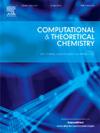Investigation of the Quinoidal resonance effect towards chromophores in chloroform medium for organic solar cell applications: A DFT/TD-DFT study
IF 3
3区 化学
Q3 CHEMISTRY, PHYSICAL
引用次数: 0
Abstract
Unfused quinoidal π–spacers were utilized to assess their impact on the optoelectronic and photovoltaic properties. The M06/6-311G(d,p) level was applied to investigate these properties of designed derivatives. All the proposed molecules showed narrow band gaps (1.47 to 2.25 eV) and wide absorption spectra (666.08–960.07 nm). Significant amount of charge transfer from the central core towards terminal acceptors was indicated by the TDM and hole-electron maps. Lower values of binding energy (0.18–0.37 eV) showed higher exciton dissociation rate in derivatives. The compound (IND5) showed the most favorable properties among all derivatives i.e., least band gap (1.47 eV), highest bathochromic shift (960.08 nm) and minimal binding energy (0.18 eV). From the photovoltaic insight, the derivatives showed significant values of Voc (1.11–1.79 V), PCE (15.33–25.15 %) and FF (0.76–0.96). Our study reveals profound insights into the design principles of optimizing the performance of organic solar cell applications based on quinoidal π − conjugated compounds.

有机太阳能电池中氯仿介质中发色团的Quinoidal共振效应的研究:DFT/TD-DFT研究
利用未融合的quinoidal π-spacers来评估其对光电和光伏性能的影响。采用M06/6-311G(d,p)水平考察了所设计衍生物的这些性质。所有分子都具有窄带隙(1.47 ~ 2.25 eV)和宽吸收光谱(666.08 ~ 960.07 nm)。TDM和空穴电子图显示了从中心核向终端受体的大量电荷转移。较低的结合能值(0.18-0.37 eV)表明衍生物的激子解离率较高。化合物IND5的带隙最小(1.47 eV),色移最大(960.08 nm),结合能最小(0.18 eV)。从光伏角度来看,这些衍生物的Voc(1.11-1.79 V)、PCE(15.33-25.15 %)和FF(0.76-0.96)值显著。我们的研究揭示了基于quinoidal π − 共轭化合物优化有机太阳能电池应用性能的设计原则。
本文章由计算机程序翻译,如有差异,请以英文原文为准。
求助全文
约1分钟内获得全文
求助全文
来源期刊

Computational and Theoretical Chemistry
CHEMISTRY, PHYSICAL-
CiteScore
4.20
自引率
10.70%
发文量
331
审稿时长
31 days
期刊介绍:
Computational and Theoretical Chemistry publishes high quality, original reports of significance in computational and theoretical chemistry including those that deal with problems of structure, properties, energetics, weak interactions, reaction mechanisms, catalysis, and reaction rates involving atoms, molecules, clusters, surfaces, and bulk matter.
 求助内容:
求助内容: 应助结果提醒方式:
应助结果提醒方式:


